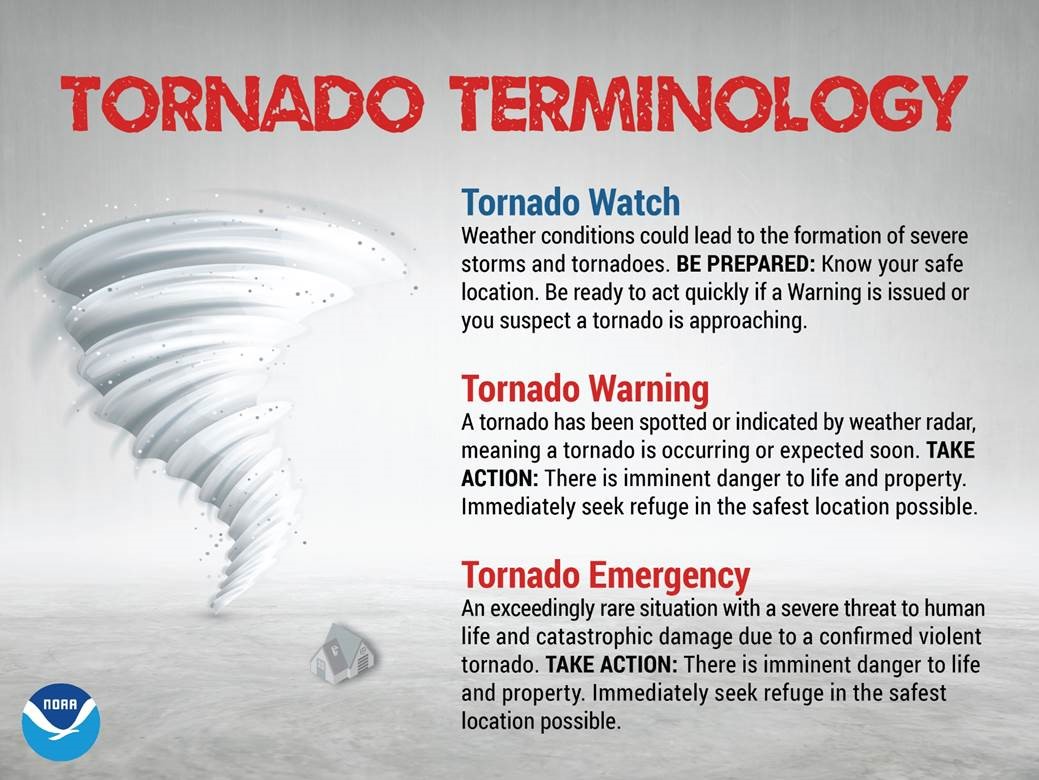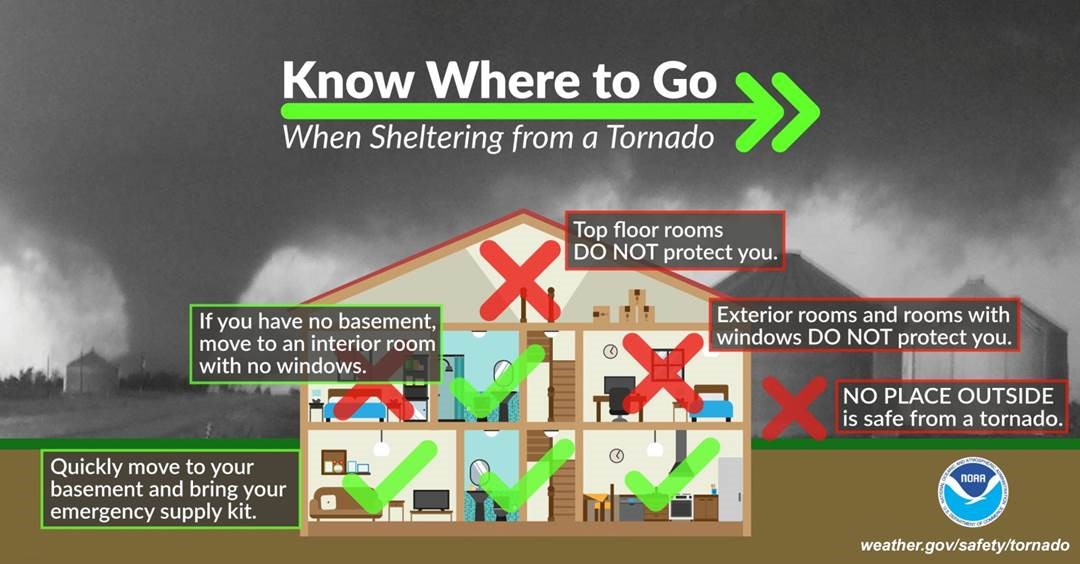|
Tornadoes/Severe Thunderstorms |
Tornadoes are nature’s most violent storms.
Spawned from powerful thunderstorms, tornadoes can cause fatalities and devastate a neighborhood in seconds. Tornadoes strike with little or no warning.
Understand these terms:
Tornado Watch: Tornados are possible.
Tornado Warning: Take shelter; tornado sighted.
Severe Thunderstorm Watch: Severe thunderstorms are possible.
Severe Thunderstorm Warning: Severe thunderstorms are occurring.

The National Weather Service (NWS) Storm Prediction Center provides these tornado safety tips:
- In a house with no basement, a dorm, or an apartment:
- Avoid windows.
- Go to the lowest floor, small center room (like a bathroom or closet), under a stairwell, or in an interior hallway with no windows.
- Crouch as low as possible to the floor, facing down; and cover your head with your hands. A bath tub may offer a shell of partial protection.
- Even in an interior room, you should cover yourself with some sort of thick padding (mattress, blankets, etc.), to protect against falling debris in case the roof and ceiling fail. A helmet can offer some protection against head injury.
- In an office building, hospital, nursing home or skyscraper:
- Go directly to an enclosed, windowless area in the center of the building -- away from glass and on the lowest floor possible.
- Crouch down and cover your head.
- Interior stairwells are usually good places to take shelter, and if not crowded, allow you to get to a lower level quickly.
- Stay off the elevators; you could be trapped in them if the power is lost.
- In a mobile home:
- Get out! Even if your home is tied down, it is not as safe as an underground shelter or permanent, sturdy building.
- Go to a shelter, or nearby permanent structure, using your tornado evacuation plan. Most tornadoes can destroy even tied-down mobile homes.
- At school:
- Follow the drill! Go to the interior hall or windowless room in an orderly way as you are told.
- Crouch low, head down, and protect the back of your head with your arms.
- Stay away from windows and large open rooms like gyms and auditoriums.
- In a car or truck: Vehicles are extremely risky in a tornado. There is no safe option when caught in a tornado in a car, just slightly less-dangerous ones.
- If the tornado is visible, far away, and the traffic is light, you may be able to drive out of its path by moving at right angles to the tornado.
- Seek shelter in a sturdy building, or underground if possible.
- If you are caught by extreme winds or flying debris, park the car as quickly and safely as possible -- out of the traffic lanes.
- Stay in the car with the seat belt on.
- Put your head down below the windows; cover your head with your hands and a blanket, coat, or other cushion if possible.
- If you can safely get noticeably lower than the level of the roadway, leave your car and lie in that area, covering your head with your hands.
- Avoid seeking shelter under bridges, which can create deadly traffic hazards while offering little protection against flying debris.
- If the tornado is visible, far away, and the traffic is light, you may be able to drive out of its path by moving at right angles to the tornado.
- In the open outdoors:
- If possible, seek shelter in a sturdy building.
- If not, lie flat and face-down on low ground, protecting the back of your head with your arms.
- Get as far away from trees and cars as you can; they may be blown onto you in a tornado.

Additional Resources:
- Forecasts: National Weather Service
- Local Traffic: Houston TranStar
- Tornadoes: https://www.ready.gov/tornadoes
- Flooding: http://www.nws.noaa.gov/os/water/tadd/ or https://www.ready.gov/floods
- Lightning: http://www.lightningsafety.noaa.gov/outdoors.shtml
Preparedness & Emergency Information: http://www.readyharris.org/ or www.lonestar.edu/oem
